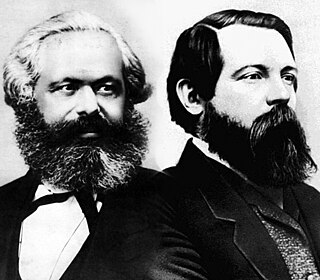Related Research Articles
The division of labour is the separation of tasks in any economic system so that participants may specialize (specialization). Individuals, organizations, and nations are endowed with or acquire specialized capabilities and either form combinations or trade to take advantage of the capabilities of others in addition to their own. Specialized capabilities may include equipments or natural resources in addition to skills and training and complex combinations of such assets are often important, as when multiple items of specialized equipments and skilled operators are used to produce a single product. The division of labour is the motive for trade and the source of economic interdependence.

Labour economics seeks to understand the functioning and dynamics of the markets for wage labour. Labour is a commodity that supplied by labourers in exchange for a wage paid by demanding firms.
A tax is a compulsory financial charge or some other type of levy imposed upon a taxpayer by a governmental organization in order to fund various public expenditures. A failure to pay, along with evasion of or resistance to taxation, is punishable by law. Taxes consist of direct or indirect taxes and may be paid in money or as its labour equivalent. The first known taxation took place in Ancient Egypt around 3000–2800 BC.
Human capital is the stock of habits, knowledge, social and personality attributes embodied in the ability to perform labour so as to produce economic value.
Classical economics or classical political economy is a school of thought in economics that flourished, primarily in Britain, in the late 18th and early-to-mid 19th century. Its main thinkers are held to be Adam Smith, Jean-Baptiste Say, David Ricardo, Thomas Robert Malthus, and John Stuart Mill. These economists produced a theory of market economies as largely self-regulating systems, governed by natural laws of production and exchange.
Employment is a relationship between two parties, usually based on a contract where work is paid for, where one party, which may be a corporation, for profit, not-for-profit organization, co-operative or other entity is the employer and the other is the employee. Employees work in return for payment, which may be in the form of an hourly wage, by piecework or an annual salary, depending on the type of work an employee does or which sector they are working in. Employees in some fields or sectors may receive gratuities, bonus payment or stock options. In some types of employment, employees may receive benefits in addition to payment. Benefits can include health insurance, housing, disability insurance or use of a gym. Employment is typically governed by employment laws, organisation or legal contracts.

The General Theory of Employment, Interest and Money of 1936 is the last and most important book by the English economist John Maynard Keynes. It created a profound shift in economic thought, giving macroeconomics a central place in economic theory and contributing much of its terminology – the "Keynesian Revolution". It had equally powerful consequences in economic policy, being interpreted as providing theoretical support for government spending in general, and for budgetary deficits, monetary intervention and counter-cyclical policies in particular. It is pervaded with an air of mistrust for the rationality of free-market decision making.
An investor is a person that allocates capital with the expectation of a future financial return or to gain an advantage. Types of investments include: equity, debt securities, real estate, currency, commodity, token, derivatives such as put and call options, futures, forwards, etc. This definition makes no distinction between the investors in the primary and secondary markets. That is, someone who provides a business with capital and someone who buys a stock are both investors. An investor who owns a stock is a shareholder.
Productivity describes various measures of the efficiency of production. Often, a productivity measure is expressed as the ratio of an aggregate output to a single input or an aggregate input used in a production process, i.e. output per unit of input, typically over a specific period of time. Most common example is the (aggregate) labour productivity measure, e.g., such as GDP per worker. There are many different definitions of productivity and the choice among them depends on the purpose of the productivity measurement and/or data availability. The key source of difference between various productivity measures is also usually related to how the outputs and the inputs are aggregated into scalars to obtain such a ratio-type measure of productivity.
The workforce or labour force is the labour pool in employment. It is generally used to describe those working for a single company or industry, but can also apply to a geographic region like a city, state, or country. Within a company, its value can be labelled as its "Workforce in Place". The workforce of a country includes both the employed and the unemployed. The labour force participation rate, LFPR, is the ratio between the labour force and the overall size of their cohort. The term generally excludes the employers or management, and can imply those involved in manual labour. It may also mean all those who are available for work.

Wage labour is the socioeconomic relationship between a worker and an employer, where the worker sells their labour power under a formal or informal employment contract. These transactions usually occur in a labour market where wages or salaries are market-determined.
The Harrod–Domar model is a Keynesian model of economic growth. It is used in development economics to explain an economy's growth rate in terms of the level of saving and productivity of capital. It suggests that there is no natural reason for an economy to have balanced growth. The model was developed independently by Roy F. Harrod in 1939, and Evsey Domar in 1946, although a similar model had been proposed by Gustav Cassel in 1924. The Harrod–Domar model was the precursor to the exogenous growth model.
Workfare is an alternative, and controversial, way of providing money to otherwise unemployed or underemployed people, who are applying for social benefits. The term was first introduced by civil rights leader James Charles Evers in 1968; however, it was popularized by Richard Nixon in a televised speech August 1969. An early model of workfare had been pioneered in 1961 by Joseph Mitchell in Newburgh, New York.
Productive and unproductive labour are concepts that were used in classical political economy mainly in the 18th and 19th centuries, which survive today to some extent in modern management discussions, economic sociology and Marxist or Marxian economic analysis. The concepts strongly influenced the construction of national accounts in the Soviet Union and other Soviet-type societies.
Flexicurity is a welfare state model with a pro-active labour market policy. The term was first coined by the social democratic Prime Minister of Denmark Poul Nyrup Rasmussen in the 1990s.

Reserve army of labour is a concept in Karl Marx's critique of political economy. It refers to the unemployed and underemployed in capitalist society. It is synonymous with "industrial reserve army" or "relative surplus population", except that the unemployed can be defined as those actually looking for work and that the relative surplus population also includes people unable to work. The use of the word "army" refers to the workers being conscripted and regimented in the workplace in a hierarchy under the command or authority of the owners of capital.
A job guarantee (JG) is an economic policy proposal aimed at providing a sustainable solution to the dual problems of inflation and unemployment. Its aim is to create full employment and price stability, by having the state promise to hire unemployed workers as an employer of last resort (ELR).

Technological unemployment is the loss of jobs caused by technological change. It is a key type of structural unemployment.

The working class comprises those engaged in waged or salaried labour, especially in manual-labour occupations and industrial work. Working-class occupations include blue-collar jobs, some white-collar jobs, and most pink-collar jobs. Members of the working class rely for their income exclusively upon their earnings from wage labour; thus, according to the more inclusive definitions, the category can include almost all of the working population of industrialized economies, as well as those employed in the urban areas of non-industrialized economies or in the rural workforce.
"Surplus value" is a translation of the German word "Mehrwert", which simply means value added, and is cognate to English "more worth". Surplus-value is the difference between the amount raised through a sale of a product and the amount it cost to the owner of that product to manufacture it: i.e. the amount raised through sale of the product minus the cost of the materials, plant and labour power. It is a central concept in Karl Marx's critique of political economy. Conventionally, value-added is equal to the sum of gross wage income and gross profit income. However, Marx uses the term Mehrwert to describe the yield, profit or return on production capital invested, i.e. the amount of the increase in the value of capital. Hence, Marx's use of Mehrwert has always been translated as "surplus value", distinguishing it from "value-added". According to Marx's theory, surplus value is equal to the new value created by workers in excess of their own labor-cost, which is appropriated by the capitalist as profit when products are sold.
References
- ↑ interview with Louis Kelso, originator of Binary economics
- ↑ James S. Albus Archived 2007-09-29 at the Wayback Machine , Peoples' Capitalism (1976).